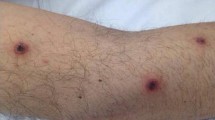Abstract
Fusarium species are hyaline moulds belonging to the hyalohyphomycosis group that are usually found in the soil and plants. This organism has emerged as a cause of disseminated invasive disease. The correlation between in vitro value and clinical efficacy is low and many patients remain unresponsive to treatment despite in vitro susceptibility. We determined growth control for Fusarium solani using the BioCell-Tracer® system that measures the growth rate of a single fungal hypha, and the effect of different concentrations of amphotericin B and itraconazole. The MIC for these two drugs was also determined by a broth microdilution technique, using RPMI 1640. Different MICs for amphotericin B were obtained by the two different methods. This paper describes a case of infection due to Fusarium solani in an allogeneic bone marrow transplanted patient, the microbiological diagnostic, antifungal susceptibility tests for conidia and hypha and clinical correlation.
Similar content being viewed by others
References
I Raad R Hachen (1995) ArticleTitleTreatment of central venous catheter-related fungemia due to Fusarium oxysporum Clin Infect Dis 20 709–711 Occurrence Handle7756502
G Castellá J Cano J Guarro FJ Cabañes (1999) ArticleTitleDNA fingerprinting of Fusarium solani isolates related to cutaneous infection in a sea turtle Med Mycol 37 223–226 Occurrence Handle10.1046/j.1365-280X.1999.00223.x Occurrence Handle10421856
I Raad J Tarrand H Hanna M Albitar E Janssen M Boktour G Bodey M Mardani R Hachem D Kontoyiannis E Whimbey K Rolston (2002) ArticleTitleEpidemiology, Molecular Mycology and Environmental sources of Fusarium infection in patients with cancer Infect Control Hosp Epidemiol 23 IssueID9 532–537 Occurrence Handle12269452
V Letscher-Bru F Campos J Waller R Randriamahazaka E Candolfi R Herbrecht (2002) ArticleTitleSuccessful outcome of treatment of a disseminated infection due to Fusarium dimerium in a leukemia patient J Clin Microbiol 40 IssueID3 1100–1102 Occurrence Handle10.1128/JCM.40.3.1100-1102.2002 Occurrence Handle11880452
Y Sugiura JR Barr DB Barr JW Brock CM Elie Y Ueno DGJ Patterson ME Potter E Reiss (1999) ArticleTitlePhysiological characteristics and mycotoxins of human clinical isolates of Fusarium species Mycol Rev 103 IssueID11 1462–1468 Occurrence Handle10.1017/S095375629900862X
M Nutti E Anaissie (2002) ArticleTitleCutaneous infection by Fusarium species in healthy and immunocompromised host: implications for diagnosis and management Clin Infect Dis 35 909–920 Occurrence Handle10.1086/342328 Occurrence Handle12355377
T Yildiran (1998) ArticleTitleFusarium fungaemia in severely neutropenic patients Mycoses 41 467–469 Occurrence Handle9919888
National Committee for Clinical Laboratory Standards. Reference method for broth dilution antifungal susceptibility testing of conidium-forming filamentous fungi. Approved standard M38-A. National Committee for Clinical Laboratory Standards 2002; Wayne, PA
Bezjak V. Standardization of a hyphal inoculum of Aspergilli for amphotericin B susceptibility testing. J Clin Microbiol 1985; Apr: 509–512
H Taguchi M Miyaji K Nishimura Min-Li Xu (1995) ArticleTitleStudied on the synergistic effect of amphotericin B and 5-fluorocytosine on the growth rate of single hyphae of Aspergillus fumigatus by a Biocell-tracer system Mycoscience 36 341–344
Gerlach W, Nirenberg H. The Genus Fusarium: a Pictorial Atlas. Institut fur Mikrobiologie Berlin-Dahlem: Biologische Bundesanstalt fur Land-und Forstwirlschaft,3-489-20900-1. 1982; 363–368
M Katsu S Kidd A Ando ML Moretti-Branchini Y Mikami K Nishimura W Meyer (2004) ArticleTitleThe internal transcribed spacers and 5.8S rRNA gene show extensive diversity among isolates of the Cryptococcus neoformans species complex FEMS Yeast Res 4 377–388 Occurrence Handle10.1016/S1567-1356(03)00176-4 Occurrence Handle14734018
CP Kartzman CJ Robnett (1998) ArticleTitleIdentification and phylogeny of ascomycetous yeasts from analysis of nuclear large subunit (26S) ribosomal DNA partial sequences Antonie Leeuwenhoek 73 331–371 Occurrence Handle10.1023/A:1001761008817 Occurrence Handle9850420
M Nucci KA Marr F Queiroz-Telles CA Martins P Trabasso S Costa JC Voltarelli AL Colombo A Imhof R Pasquini A Maiolino CA Souza E Anaissie (2004) ArticleTitleFusarium infection in hematopoietic stem cell transplant recipients Clin Infect Dis 38 1237–1242 Occurrence Handle10.1086/383319 Occurrence Handle15127334
M Kami U Machida K Okuzumi T Matsumura SI Mori A Hori T Kashima Y Kanda Y Takaue H Sakamaki (2002) ArticleTitleEffect of fluconazole prophylaxis on fungal blood cultures: an autopsy-based study involving 720 patients with haematological malignancy Br J Haematol 117 40–46 Occurrence Handle10.1046/j.1365-2141.2002.03414.x Occurrence Handle11918531
L Ostrosky-Zeichner KA Marr JH Rex SH Cohen (2003) ArticleTitleAmphotericin B: time for a new “Gold Standard” Clin Infect Dis 37 415–425 Occurrence Handle10.1086/376634 Occurrence Handle12884167
ABA Teixeira P Trabasso ML Moretti FH Aoki AC Vigorito M Miyaji Y Mikami M Takada AZ Schreiber (2003) ArticleTitlePhaeohyphomycosis caused by Chaetomium globosum in an allogeneic bone marrow transplant recipient Mycophatologia 156 309–312 Occurrence Handle10.1023/B:MYCO.0000003563.29320.95
Samuel R, Truant AL, Suh B. Cumitech 42, Infections in Hemopoietic StemCell Transplant Recipients. In: Truant AL, ed. Coordinating. ASM Press, Washington, DC, 2005
J Guarro C Llop C Aguilar I Pujol (1997) ArticleTitleComparison of in vitro antifungal susceptibilities of conidia and hyphae of filamentous fungi Antimicrob Agents Chemother 41 IssueID12 2760–2762 Occurrence Handle9420054
Author information
Authors and Affiliations
Corresponding author
Rights and permissions
About this article
Cite this article
Teixeira, A.B.A., Moretti, M.L., Trabasso, P. et al. Evaluation of Fusarium solani Hyphae and Conidia Susceptibility to Amphotericin B and Itraconazole: Study of a Clinical Case. Mycopathologia 160, 291–296 (2005). https://doi.org/10.1007/s11046-005-0106-2
Received:
Accepted:
Issue Date:
DOI: https://doi.org/10.1007/s11046-005-0106-2




